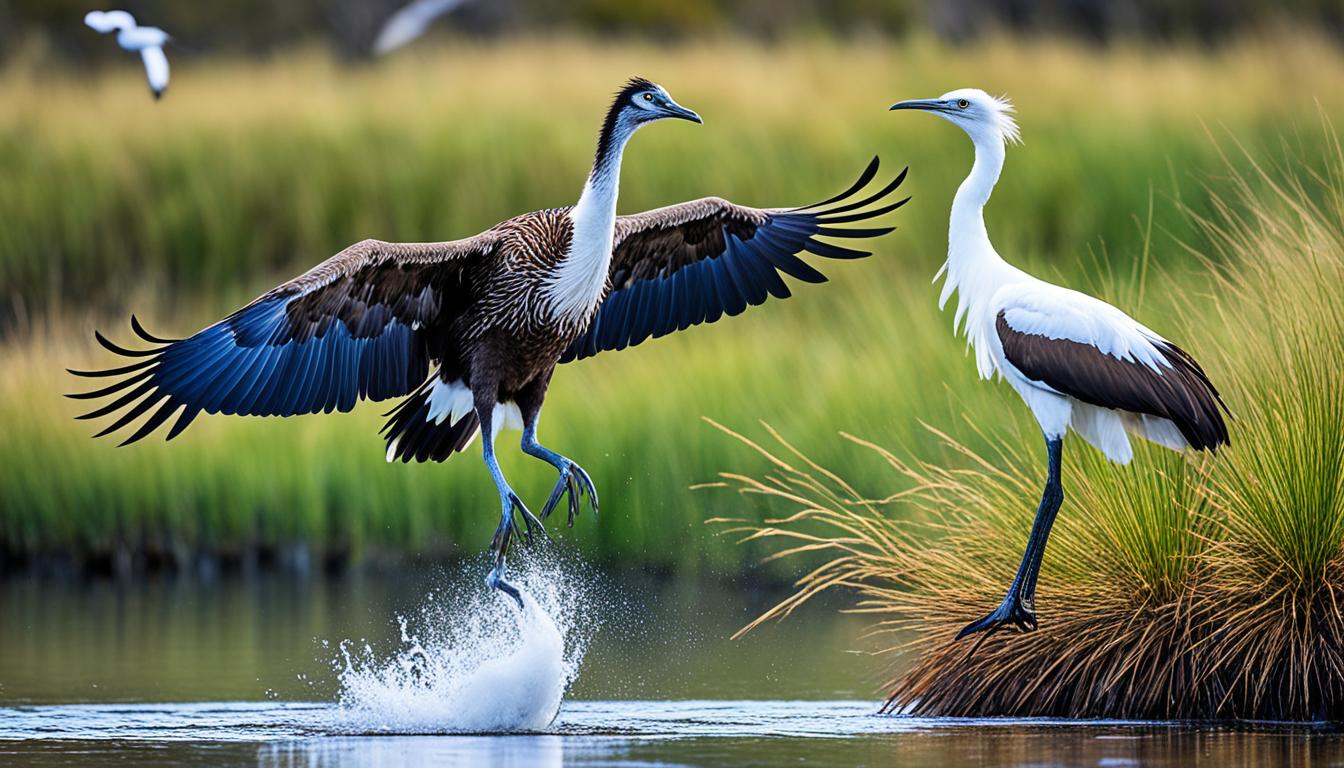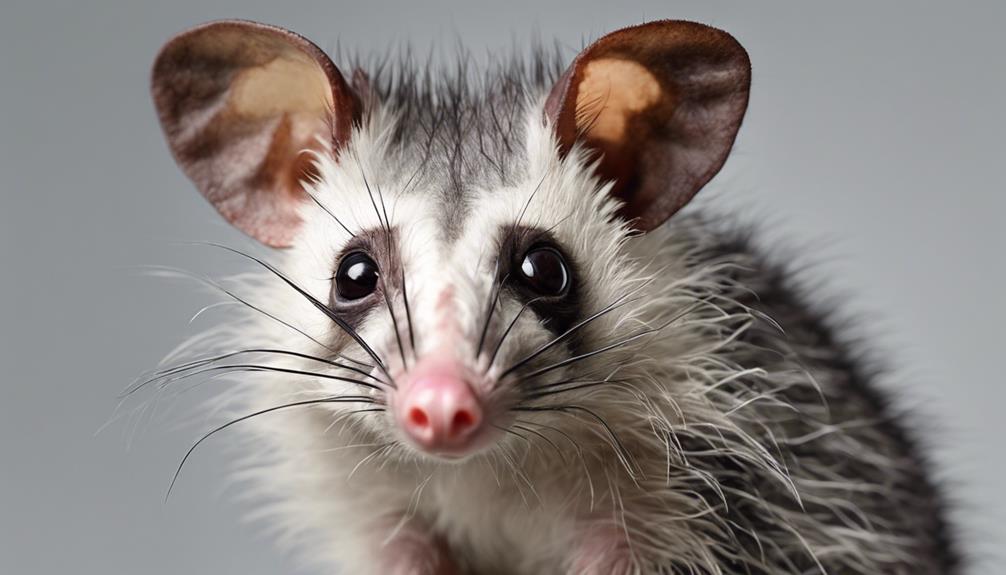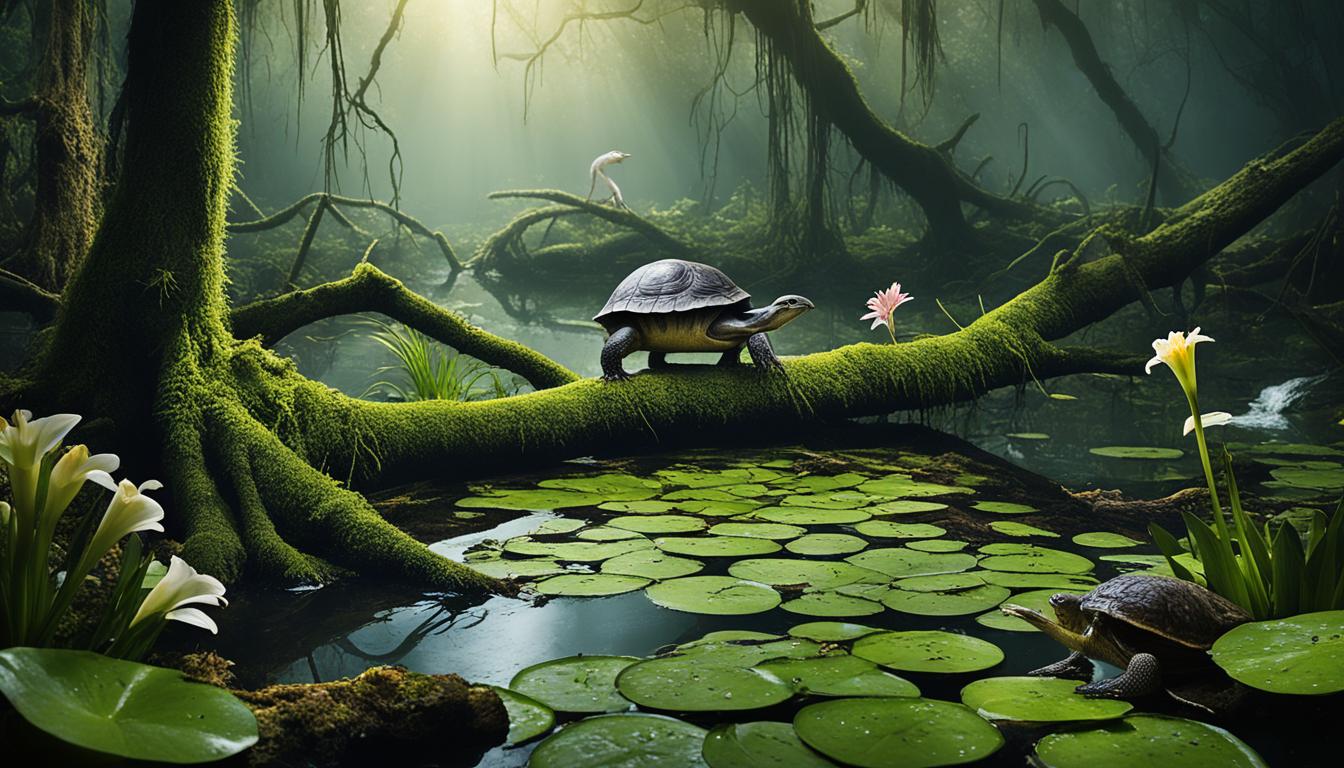Did you know that there are several captivating animals that begin with the letter E? From impressive elephants to enigmatic eels, these creatures fascinate us with their distinctive traits and behaviors. Let’s delve into the realm of extraordinary animals and discover the marvels that lie ahead!
Key Takeaways:
- Animals that start with E encompass a wide range of species from diverse habitats.
- Elephants are the largest land animals and are known for their iconic features.
- Eels possess a fascinating electric shock mechanism.
- Eagles are mighty birds of prey with excellent hunting abilities.
- Elk are impressive herbivores, known for their massive size.
Elephants – Majestic Giants of the Land
Elephants, the largest land animals in the world, are truly magnificent creatures that captivate the imagination. With their iconic features such as flapping ears, long trunks, and large ivory tusks, elephants are easily recognizable and hold a special place in our hearts.
Did you know that an elephant’s tusks are actually elongated incisor teeth? These impressive tusks can grow to be several feet long and are used for various purposes including digging, lifting objects, and even as weapons for protection. Unfortunately, the ivory trade has resulted in a significant decline in elephant populations as these tusks are highly sought after.
Elephants can be found in various parts of the world, including Africa and Asia. There are two main species, the African elephant and the Asian elephant, each with their own unique characteristics. African elephants are larger in size and have larger ears, while Asian elephants have smaller ears and a more rounded back.
The Role of Elephants in Ecosystems
Elephants play a crucial role in their ecosystems. As herbivores, they consume large quantities of vegetation, shaping the landscape and creating open spaces for other species. In this way, they act as ecosystem engineers, influencing the distribution and abundance of plants and providing habitats for smaller animals.
Furthermore, elephants have a profound impact on the availability of water sources. They dig water holes with their trunks, helping to create drinking spots for themselves and other animals during dry seasons. These water holes also benefit plants and contribute to overall ecosystem health.
“Elephants are not only the largest land animals, but they are also highly intelligent and socially complex. They live in tight-knit family groups called herds, led by a matriarch.”
Elephants are not only the largest land animals but are also highly intelligent and socially complex. They live in tight-knit family groups called herds, led by a matriarch. Within these herds, elephants form strong bonds and exhibit behaviors such as communication through vocalizations, gestures, and touching.
The Threats Facing Elephants
Despite their strength and resilience, elephants face numerous threats that endanger their survival. The most pressing threat is poaching for their ivory tusks, which drives illegal wildlife trade and decimates elephant populations. Deforestation and habitat loss also pose significant challenges as elephant habitats are continually encroached upon by human activities.
Conservation efforts are crucial in protecting these majestic giants and securing their future. Organizations and initiatives focused on anti-poaching, habitat protection, and community engagement play a vital role in ensuring the survival of elephants and maintaining the delicate balance of ecosystems they inhabit.
| Key Facts about Elephants | African Elephants | Asian Elephants |
|---|---|---|
| Scientific Name | Loxodonta | Elephas |
| Size | Largest land animals, up to 13 feet tall at the shoulder | Smaller than African elephants, up to 9 feet tall at the shoulder |
| Weight | Adult males: 10,000-13,000 pounds; adult females: 6,000-9,000 pounds | Adult males: 5,000-11,000 pounds; adult females: 4,000-6,000 pounds |
| Lifespan | Average of 60-70 years | Average of 60-75 years |
| Conservation Status | Vulnerable | Endangered |
Despite the challenges they face, elephants continue to inspire awe and admiration among people around the world. These majestic giants serve as a reminder of the incredible diversity and beauty of our planet’s wildlife.
Stay tuned for the next section, where we delve into the world of eels, the masters of electric shock.
Eels – Masters of Electric Shock
The electric eel is a fascinating freshwater fish native to South America. What sets this creature apart is its remarkable ability to produce electric shocks, making it a true master of electric shock in the animal kingdom. With its shocking mechanism, the electric eel has captivated the attention of scientists and nature enthusiasts alike.
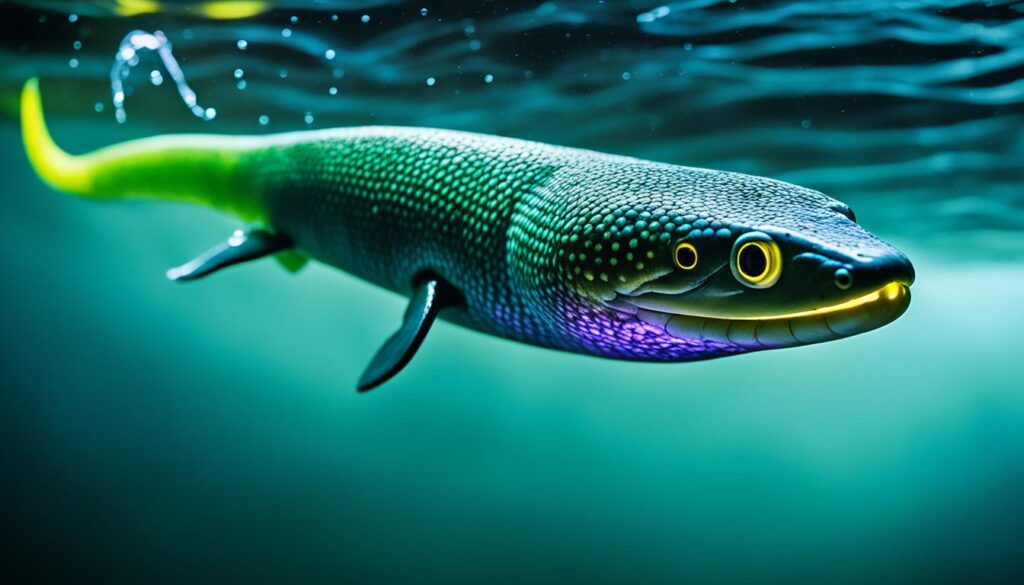
Electric eels possess a unique organ known as the electric organ, which spans almost the entire length of their bodies. This specialized organ contains thousands of cells called electrocytes that work together to generate electric shocks. These shocks can reach astonishing voltages of up to 800 volts, making the electric eel one of the most powerful electric generators in the animal world.
The electric eel’s electric shocks serve multiple purposes. They are primarily used for hunting and defense. When hunting, the eel emits high-voltage electric pulses that allow it to detect prey in its nearby environment. Once a potential meal is detected, the eel delivers a powerful electric shock that stuns or kills the prey, making it easier to capture and consume.
Furthermore, electric eels use their electric shocks for self-defense. When threatened, they can discharge a powerful shock that acts as a deterrent to potential predators. This shocking defense mechanism is highly effective, keeping most predators at bay and allowing the eel to escape unharmed.
Electric eels are typically found in freshwater habitats, such as rivers, swamps, and flooded forests. They prefer slow-moving or stagnant waters where they can camouflage themselves among vegetation and strike unsuspecting prey. These remarkable creatures can grow up to eight feet in length, further adding to their awe-inspiring presence.
“The electric eel’s ability to produce electric shocks is truly remarkable, showcasing the incredible diversity of adaptations found in freshwater fish.” – Dr. Jane Fisher, Marine Biologist
Studying electric eels provides valuable insights into the world of bioelectricity and the intricate mechanisms that allow certain organisms to harness and generate electric energy. These discoveries not only deepen our understanding of the natural world but also have the potential to inspire new technologies and medical advancements.
| Electric Eel Facts | |
|---|---|
| Scientific Name | Electrophorus electricus |
| Habitat | Freshwater ecosystems of South America |
| Size | Can grow up to eight feet in length |
| Electric shock voltage | Up to 800 volts |
| Shock purpose | Hunting and self-defense |
The electric eel’s mastery over electric shock is a testament to the wonders of nature. With its unique abilities and adaptations, this freshwater fish continues to intrigue and inspire awe in those who encounter it. Exploring the shocking mechanisms and behaviors of electric eels reveals the extraordinary diversity of life on our planet.
Eagles – Mighty Birds of Prey
Eagles are powerful birds of prey known for their sharp talons and excellent hunting abilities. The bald eagle, in particular, is the national symbol of the United States.
Eagles have large beaks and talons that enable them to catch and feed on vertebrates. These majestic birds are also known for their monogamous mating behavior, with pairs often staying together for life.
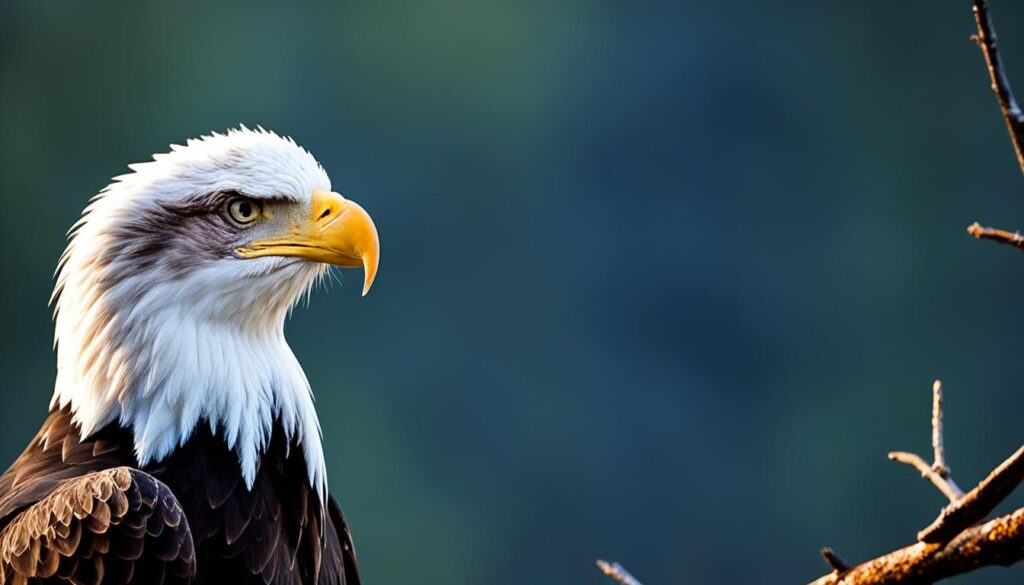
Eagles are frequently admired for their graceful flight and keen eyesight. They soar through the sky with incredible agility, using their exceptional hunting skills to locate and capture prey from a distance.
Eagles are fascinating creatures, representing strength, freedom, and resilience. Their ability to survive and thrive in various habitats around the world is a testament to their adaptability and predatory prowess.
Elk – Majestic Members of the Deer Family
Elk, also known as wapiti, are native to North America and hold the esteemed title of being the largest deer species. With their impressive size, magnificent antlers, and graceful movements, elk are truly majestic creatures that symbolize the untamed wilderness and natural beauty.
These magnificent animals can reach towering heights of over seven feet at the shoulder and weigh up to a staggering 700 pounds. Their sheer size and presence command attention and admiration, making them an awe-inspiring sight in their native habitats.
Elk possess remarkable antlers, which are exclusive to male individuals. These antlers can grow to extraordinary sizes, spanning up to four feet and weighing up to 40 pounds. They undergo an annual cycle of growth, shedding, and regrowth, serving as a visual representation of the elk’s vitality and dominance during mating season.
Elk are known for their agile and swift movements, enabling them to navigate rugged terrains with ease. They are powerful and nimble, effortlessly leaping over obstacles and traversing vast distances in search of food and water.
The native range of elk spans across various regions of North America, including the Rocky Mountains, the Great Plains, and the Pacific Northwest. These iconic animals have adapted to diverse ecosystems, from dense mountain forests to open grasslands, showcasing their resilience and ability to thrive in a range of habitats.
Elk play an essential role in maintaining the balance of their ecosystems. They are herbivores, consuming a diet primarily composed of grasses, shrubs, and bark. As they graze, they shape the landscape, influencing the growth and distribution of vegetation and providing opportunities for other species to thrive.
| Key Features of Elk | Description |
|---|---|
| Impressive Size | Elk can reach heights of over seven feet and weigh up to 700 pounds, making them the largest members of the deer family. |
| Majestic Antlers | Male elk grow massive antlers, spanning up to four feet and weighing up to 40 pounds, showcasing their strength and dominance. |
| Graceful Movements | Elk exhibit agility and nimbleness, effortlessly navigating through various terrains in search of food and water. |
| Diverse Habitat Range | Elk can be found in different habitats, from dense forests to open grasslands, showcasing their adaptability. |
Observing these majestic creatures in the wild is an unforgettable experience, immersing us in the splendor of nature and reminding us of the remarkable diversity that exists within the animal kingdom.

Fun Fact:
“The distinctive bugle of an elk during the rutting season is a mesmerizing sound that echoes through the forests, serving as an extraordinary display of their strength and dominance.”
Echidnas – Unique Egg-Laying Mammals
Echidnas are fascinating animals that resemble a hybrid of a porcupine and an anteater. These Australian natives have quills and a long nose, which they use to hunt for insects. What makes echidnas truly unique is that they are one of the few mammals that lay eggs. This makes them a rare and intriguing species to study.

“Echidnas are remarkable creatures with extraordinary adaptations. Their ability to lay eggs sets them apart from other mammals and adds to their mystique.” – Dr. Jane Wilson, Zoologist
Echidna Characteristics
Echidnas possess several distinctive characteristics that make them intriguing creatures in the animal kingdom:
- Quills: Echidnas have spiky quills covering their bodies, acting as a defense mechanism against predators.
- Long Nose: Their elongated snouts, known as beaks, allow echidnas to probe crevices and extract prey such as ants and termites.
- Egg-Laying: Echidnas are monotremes, a group of mammals that lay eggs. Females lay a single leathery egg, which they incubate in a specialized pouch until hatching.
- Puggle: After hatching, the echidna offspring, called a puggle, remains in the pouch until it develops spines and is ready to explore the world.
Echidnas are fascinating creatures that offer a glimpse into the remarkable diversity of Australian wildlife. Their unique combination of features and egg-laying abilities make them an important species to study for evolutionary biologists and wildlife enthusiasts alike.
| Echidna Characteristics | Description |
|---|---|
| Quills | Echidnas have sharp spines covering their bodies, offering protection against predators. |
| Long Nose | Their elongated snouts, resembling anteaters, are exceptionally sensitive and help them locate food. |
| Egg-Laying | Echidnas are one of the few mammals that lay eggs, a rare reproductive adaptation. |
| Puggle | After hatching, the echidna offspring, known as a puggle, is nurtured in the mother’s pouch until it is ready to venture out. |
Emus – Flightless Birds with Incredible Speed
Emus are fascinating flightless birds native to Australia. Standing at up to six feet in height, they are the second tallest birds in the world, surpassed only by the ostrich. Despite their inability to fly, emus possess remarkable speed and agility on two legs. They are renowned for their swift running capabilities, reaching impressive speeds of up to 30 miles per hour. These unique and majestic creatures have become a symbol of the vast Australian outback and its rich biodiversity.
Emus are truly remarkable birds. Native to Australia, they have adapted to the continent’s diverse environments, from grasslands to scrublands. Although they lack the ability to take to the skies, their longer legs and powerful muscles enable them to move swiftly across the terrain, displaying extraordinary speed.
Emus belong to the ratite family, which includes other flightless birds like ostriches and rheas. With their long legs and necks, they have evolved to thrive in the Australian landscape. Emus have soft, brown feathers, providing effective camouflage amidst their natural habitats.

Characteristics of Emus:
- Height: Up to six feet
- Weight: Between 60 to 120 pounds
- Wingspan: Reduced and non-functional
- Feathers: Soft brown plumage
- Legs: Long and powerful for running
- Speed: Up to 30 miles per hour
- Preferred Habitat: Grasslands, savannas, and open woodlands
- Diet: Herbivorous, primarily feeding on plants, fruits, and seeds
The speed and agility of emus contribute to their survival in the challenging Australian environment. Their ability to cover long distances quickly allows them to find food, escape predators, and adapt to various habitats. These flightless birds have played a significant role in Australian culture and are considered a national icon.
Emus in Indigenous Culture
Emus hold a special place in the cultural heritage of Aboriginal Australians. The Emu Dreaming story is often passed down through generations and represents important teachings about survival, wisdom, and respect for the land and its creatures. Emus are regarded as symbols of strength, resilience, and connection to the Australian landscape.
The unique characteristics and behavior of emus make them a subject of fascination for researchers, conservationists, and bird enthusiasts alike. Their conservation status is currently classified as “least concern” by the International Union for Conservation of Nature (IUCN), ensuring efforts to protect their habitats and maintain their population continue.
| Interesting Facts about Emus |
|---|
| Emus have two sets of eyelids to protect their eyes from dust and sand. |
| Emus possess a highly developed sense of hearing and excellent eyesight, allowing them to detect predators from a distance. |
| During breeding season, male emus are responsible for incubating and caring for the eggs, while females move on to find new mates. |
| Emus can go for weeks without food, relying on their fat reserves during periods of scarcity. |
Egrets – Graceful Water Birds
Egrets, also known as herons, are beautiful water birds that captivate with their elegance and grace. These majestic creatures possess distinct characteristics and behaviors that set them apart in the avian world.
One of the defining features of egrets is their long legs, which allow them to navigate through marshes and shallow waters with ease. Their curved necks and sharp beaks make them adept hunters, enabling them to snatch fish and other aquatic prey with precision.
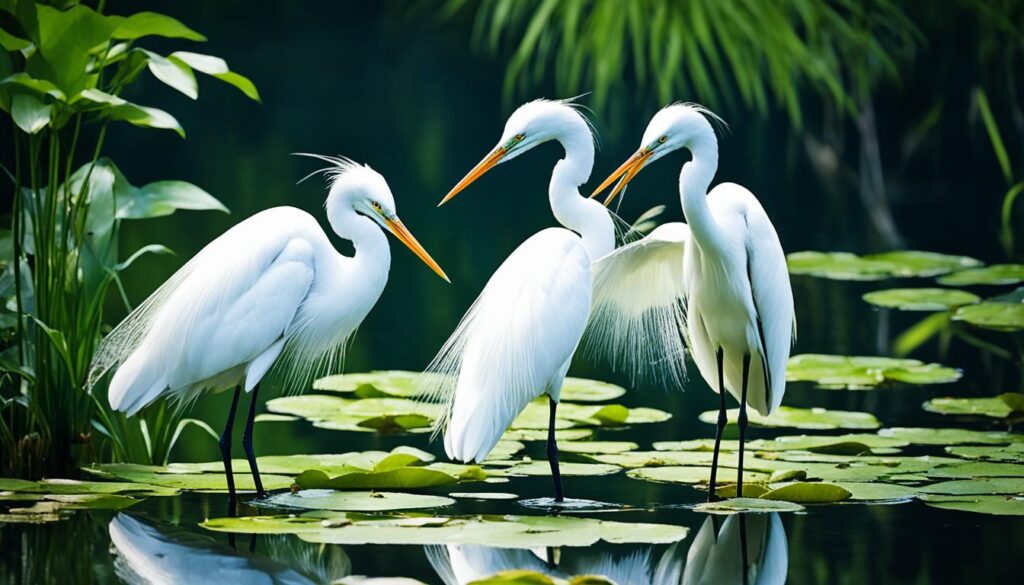
Egrets often wade in water, patiently waiting for their next meal. Their stunning white feathers provide excellent camouflage in the water, allowing them to blend seamlessly into their surroundings and surprise unsuspecting prey.
But it is in the air that egrets truly showcase their beauty. Their flight patterns are nothing short of elegant, as they glide effortlessly across the sky, their graceful wings unfurling in harmonious rhythm. It is a sight to behold, a testament to the mastery of flight that these birds possess.
Egret Characteristics:
- Long legs for easy navigation in water
- Curved necks and sharp beaks for skilled hunting
- Stunning white feathers for effective camouflage
- Elegant flight patterns that showcase their grace and agility
Through their beauty and remarkable characteristics, egrets are a true marvel of nature. They remind us of the delicate balance of ecosystems and the importance of preserving our natural world.
Elands – Massive Herbivores of Africa
Elands are truly remarkable creatures that can be found in various parts of Africa. As the largest members of the antelope family, elands are known for their impressive size and strength. Males can weigh up to 2,000 pounds and reach heights of five feet, making them a true marvel of the animal kingdom.
These majestic herbivores have a unique appearance, resembling oxen with their long bodies and powerful legs. They possess stunning spiral horns that add to their grandeur. Elands have adapted to thrive in the grasslands and savannas of Africa, where they play a vital role in maintaining the balance of ecosystems.
“The eland is a truly magnificent creature, embodying the beauty and power of African wildlife. Its presence in the grasslands is a testament to the resilience and diversity of nature.”
Unlike their slender antelope relatives, elands have a more robust build, allowing them to handle the harsh conditions of their environment. Their large size gives them a distinct advantage in fending off predators, as well as competing for mates.
Elands are primarily herbivorous, feeding on a variety of grasses and leaves. They are well-suited to survive in arid regions, as they can extract moisture from their food and go for extended periods without drinking water. This adaptability has helped them thrive in different habitats across Africa.
African Elands vs. Other Antelope
| Eland | Gemsbok | Impala |
|---|---|---|
| Largest antelope species | Distinct black and white face markings | Highly social with large herds |
| Height: Up to five feet | Long, straight horns | Fast and agile runners |
| Weight: Up to 2,000 pounds | Survives in desert regions | Distinctive reddish-brown coat |
These large herbivores are an integral part of the African ecosystem, playing a crucial role in dispersing seeds, maintaining vegetation health, and providing a food source for predators. They coexist alongside other iconic African animals, such as lions, zebras, and giraffes, contributing to the biodiversity and ecological balance of the region.

In conclusion, elands are magnificent African animals that dominate the grasslands with their impressive size and distinctive appearance. As the largest antelope species, they embody the strength and resilience of the African wilderness. Their presence adds to the richness and diversity of the continent’s wildlife, creating a harmonious tapestry of life in the savannas.
Ermines – Beautiful Creatures of the North
Ermines, also known as stoats or short-tailed weasels, are small carnivorous mammals found in Eurasia and northern North America. Despite their diminutive size, ermines are known for their elegance and grace. Their distinctive white winter coats have long been prized for their luxuriousness, with the fur once used to create royal robes in Europe.
In addition to their stunning white coats, ermines possess a unique characteristic – a distinct color change in the summer. As the temperatures rise, their fur transitions to a rich brownish hue, blending seamlessly with their natural surroundings.
“Ermines are a testament to the beauty and adaptability of nature. From their dazzling white winter coats to their earthy summer hues, these creatures capture the essence of elegance and luxury,” said Dr. Rebecca Thompson, a wildlife biologist.
This natural color variation has made ermines a symbol of both elegance and adaptability. They embody the idea that beauty can be found in every season, and that change is a part of life.
Ermines are skilled hunters, preying on small mammals, birds, and insects. Despite their small size, they are formidable predators, relying on their agility and speed to capture their prey.
Unfortunately, ermines have faced challenges due to habitat loss and trapping for their fur. Conservation efforts are crucial to protect these beautiful creatures and ensure their survival in the wild.

The Elegance of Ermines:
- Elegant white winter coats reminiscent of royal robes
- Distinctive color change in the summer to blend with their surroundings
- Skilled hunters with agility and speed
- Symbols of adaptability and beauty in every season
Efts – Poisonous Little Amphibians
Efts are the third stage in the lifecycle of the eastern newt. These bright orange amphibians have vivid black spots that serve as a warning to predators. At this stage, efts are highly poisonous, with their toxicity being 20 times more potent than in other stages of their lifecycle. This unique defense mechanism makes them a fascinating species to study.

During the eft stage, the eastern newts undergo a remarkable metamorphosis that prepares them for life on land. These small amphibians, averaging 2 to 3 inches in length, possess a toxic skin secretion containing tetrodotoxin, a potent neurotoxin. The bright coloration of efts acts as a visual signal to potential predators, warning them of the toxic defense mechanism.
Eastern Newt Lifecycle:
| Stage | Description |
|---|---|
| 1. Aquatic Larva | The larvae hatch from eggs laid in water and resemble tiny fish. They possess gills and a finned tail, allowing them to swim freely. |
| 2. Red Eft | After spending several months as larvae, the eastern newts transform into terrestrial efts. They develop lungs, lose their gills, and venture onto land. |
| 3. Aquatic Adult | At this stage, the eastern newts return to the water and undergo further metamorphosis. They develop a flattened tail, webbed hind feet, and regain their aquatic lifestyle. |
Efts have a wide range across the eastern United States and parts of Canada. They inhabit forests, swamps, and wetlands, where they forage for small invertebrates such as insects, spiders, and worms. These unique little amphibians play an important role in their ecosystems and serve as indicators of environmental health.
“The toxin produced by efts serves as a powerful deterrent to potential predators, ensuring their survival in the wild. Their bright warning coloration is a natural advertisement, cautioning animals not to make a meal out of them.”
Studying efts provides valuable insights into evolution, adaptation, and the intricate mechanisms of self-defense in the animal kingdom. Their toxic defense mechanism and vibrant appearance make them a subject of intrigue for scientists and nature enthusiasts alike.
Eiders – Duck with Valuable Feathers
Eiders are a type of duck known for their soft feathers, which are often used to create down pillows and comforters. These feathers, known as eiderdown, are highly prized for their exceptional insulation properties and luxurious feel.
Male eiders have colorful heads and bills, showcasing vibrant shades of green, blue, and white. Their striking appearance adds a splash of color to the serene waters they inhabit. On the other hand, female eiders have soft brown feathers that blend harmoniously with their natural surroundings, providing them with effective camouflage.
Not only are eiders beautiful to observe, but they also play a vital role in the textile industry. The down feathers collected from these ducks are exceptionally lightweight, yet extremely warm, making them ideal for creating high-quality bedding products.
Eiderdown is known for its superior thermal insulation, as the densely packed feathers trap air and regulate body temperature, providing a cozy and comfortable sleep experience. This natural insulation also makes eiderdown products durable and long-lasting, ensuring years of luxurious comfort.
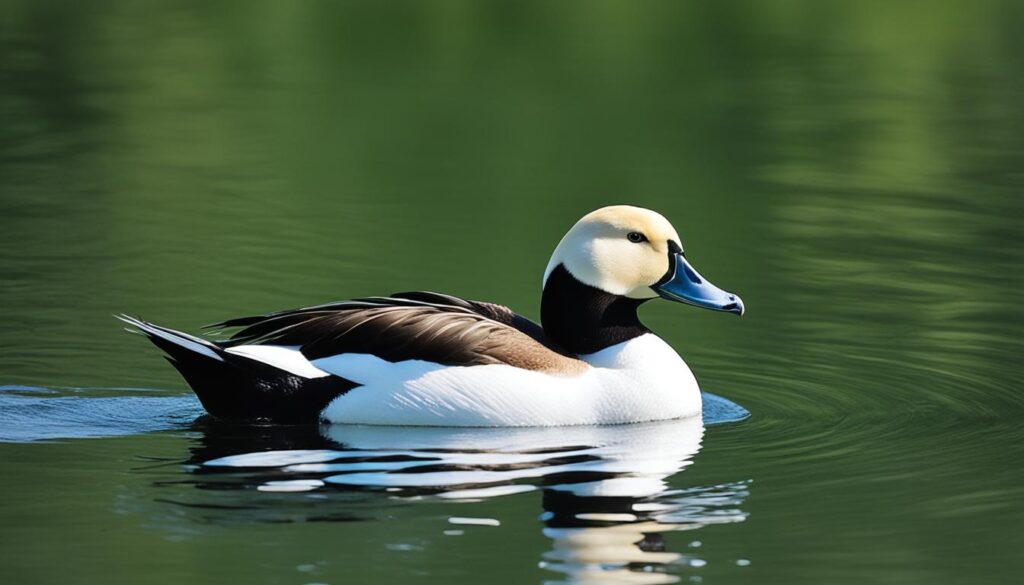
Uses of Eider Feathers
The uses of eider feathers go beyond bedding. These exquisite feathers are also sought after in the world of fashion, where they are used to create elegant clothing items and accessories.
“Eiderdown is incredibly versatile, and its soft, lightweight properties make it a prized material in the world of luxury fashion. From designer coats to hats and gloves, eider feathers add a touch of opulence and sophistication to any ensemble.” – Fashion Designer
In addition to its extraordinary insulation capabilities and aesthetic appeal, eiderdown is also hypoallergenic. This makes it an excellent choice for people with allergies, as it resists dust mites and other common allergens.
The Sustainability Factor
The collection of eiderdown feathers is carefully regulated to ensure the sustainability of both the eider population and the environment.
Eider ducks build their nests using soft down feathers, plucked from their own chests. Sustainable harvesting practices involve carefully collecting the feathers after the breeding season when the eggs have hatched and the ducks have moved on, ensuring no harm is caused to the birds or their habitats.
| Benefits of Eider Feathers | Benefits of Synthetic Materials |
|---|---|
|
|
While synthetic materials may offer certain advantages, such as lower cost and easier mass production, they cannot replicate the unique qualities and natural elegance of eiderdown.
By choosing products made with eider feathers, you not only experience a touch of luxury but also support sustainable practices that promote the well-being of eider ducks and the preservation of their habitats.
Earthworms – Unsung Heroes of the Soil
Earthworms may seem simple, but they play a crucial role in maintaining the health of the soil. With about 1,800 different species, earthworms can be found in a wide range of habitats across North America, Asia, and Europe, making them important soil dwellers.
One of the key functions of earthworms is their ability to aerate the soil. As they burrow through the ground, earthworms create tunnels that allow oxygen to reach plant roots. This helps plants grow healthier and stronger, contributing to the overall fertility of the soil.
In addition to aerating the soil, earthworms also decompose organic matter. As they consume dead plant material, earthworms break it down into smaller particles. This process, known as decomposition, releases important nutrients into the soil, enriching it and making it more suitable for plant growth.

“Earthworms are nature’s recyclers. They transform organic waste into valuable nutrients for plants,” says Dr. Linda Johnson, a soil scientist at the University of Agriculture and the author of The Earthworm Guidebook.
Furthermore, earthworms improve soil fertility by enhancing the soil structure. Their movements in the soil help create a crumbly texture, which allows water to penetrate more easily and prevents soil erosion. This helps retain moisture and nutrients, promoting healthier plant growth.
“Earthworms are like nature’s little farmers. They work tirelessly beneath the surface, improving the soil for agricultural and natural ecosystems alike,” explains Dr. Jonathan Green, an environmental scientist at SoilCare Labs.
Earthworms are adaptable creatures, capable of surviving in various habitats. They can be found in forests, grasslands, gardens, and even agricultural fields. Their ability to thrive in diverse environments demonstrates their resilience and importance in maintaining the health of ecosystems.
So the next time you come across an earthworm in your garden or while exploring the outdoors, remember the unsung heroes they are. These seemingly simple creatures are integral to the balance and vitality of the soil, ensuring that plants and other organisms can thrive.
| Earthworm Species | Habitat | Distribution |
|---|---|---|
| Eisenia fetida | Compost bins, manure piles | Worldwide |
| Lumbricus terrestris | Gardens, agricultural fields | North America, Europe, Asia, Australia |
| Octolasion cyaneum | Woodlands, grasslands | Europe, North America |
Note: Earthworm species and their distribution can vary. The table above provides examples of commonly known earthworm species and their broad habitat preferences.
Earwigs – Nocturnal Insect Pincers
Earwigs are fascinating insects known for their reddish appearance and distinctive pincers on their tails. Despite their name, earwigs do not habitually crawl into the ears of humans. Instead, these nocturnal creatures prefer to stay hidden in wet and dark places during the day, such as under rocks or in crevices. They are often found in gardens, where they can sometimes be considered pests due to their feeding habits.
Earwigs are omnivorous, feeding on both insects and plants. They use their pincers, technically called cerci, for a variety of purposes, including defense, capturing prey, and mating. These pincers, while intimidating in appearance, are not harmful to humans and are typically only used in self-defense or to capture smaller prey.
Nocturnal Behavior and Adaptations
Being primarily nocturnal, earwigs have adapted to thrive in low-light conditions. They are well-equipped with elongated antennae, which help them navigate and locate food in the dark. Earwigs have a preference for moist environments, as they are prone to desiccation, especially during dry periods.
“Contrary to popular belief, earwigs do not pose a threat to humans. They are harmless creatures that play an important role in the ecosystem by consuming other insects.”
Their diet consists of a wide range of insects, including aphids, mites, and other small invertebrates, as well as decaying plant matter. While some species of earwigs have wings, they are not strong fliers and rely mostly on their pincers and their ability to hide in small crevices for protection.
The Life Cycle of Earwigs
The life cycle of an earwig typically involves egg-laying, nymphal stages, and adulthood. Female earwigs lay their eggs in underground burrows or in the soil during the summer. Once hatched, the nymphs undergo several molts, gradually developing their distinct pincers as they mature.
While earwigs have a negative reputation, they play a crucial role in the balance of ecosystems. By consuming other insects, they help control pest populations and contribute to the overall health of plants and gardens.
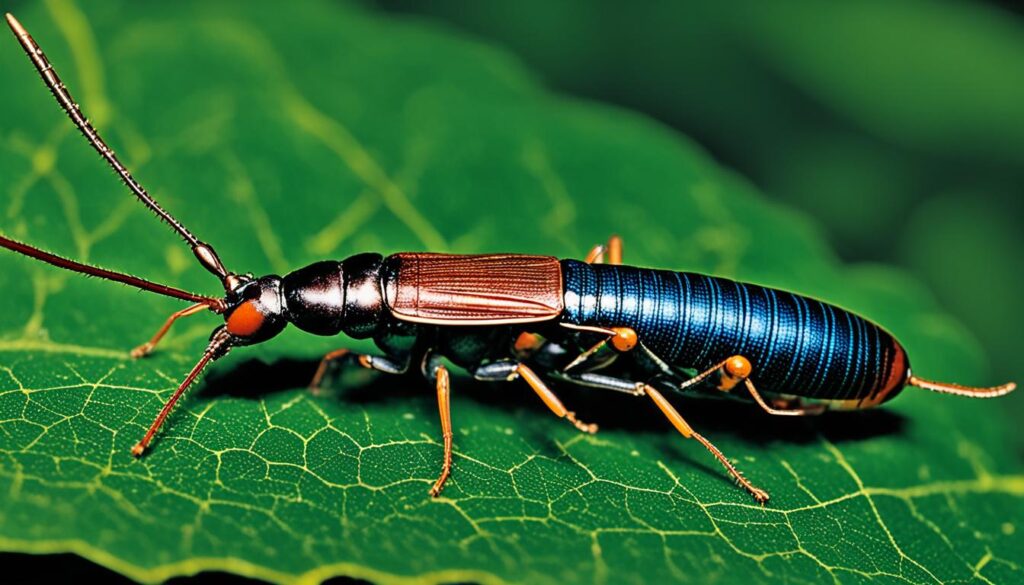
The Earwig’s Nocturnal Lifestyle
The nocturnal behavior of earwigs allows them to avoid predators and explore their environment when it is less crowded with other insects. This behavior also helps them find shelter during the day to protect themselves from extreme temperatures and potential dangers.
| Characteristics | Description |
|---|---|
| Nocturnal Activity | Earwigs are active during the night, feeding on insects and plants. |
| Prefer Moist Environments | Earwigs thrive in damp places, such as gardens, under rocks, and in rotting wood. |
| Pincers | Earwigs have specialized pincers on their tails, which they use for defense and capturing prey. |
| Omnivorous Diet | They consume a variety of insects and decaying plant matter. |
Overall, earwigs are intriguing creatures with unique adaptations that allow them to survive and thrive in various environments. While often misunderstood, their role in the ecosystem should be appreciated and respected.
Elephant Seals – Masters of the Ocean
Elephant seals are incredible marine mammals found in the North Pacific Ocean. These majestic creatures are named after their peculiar-shaped noses, which resemble an elephant’s trunk. With their massive size and unique physical features, elephant seals are truly one of nature’s wonders.
When it comes to size, elephant seals hold the title for being the largest seals in the world. These impressive creatures can weigh over 8,000 pounds and reach lengths of over 20 feet. Just imagine encountering a seal that is larger than most cars!
Although elephant seals may appear slow and cumbersome on land, they are exceptionally agile swimmers. In fact, they are renowned for their remarkable diving ability. These magnificent creatures can dive up to one mile deep, staying submerged for up to 90 minutes. Their remarkable diving skills allow them to explore the depths of the ocean and search for food.
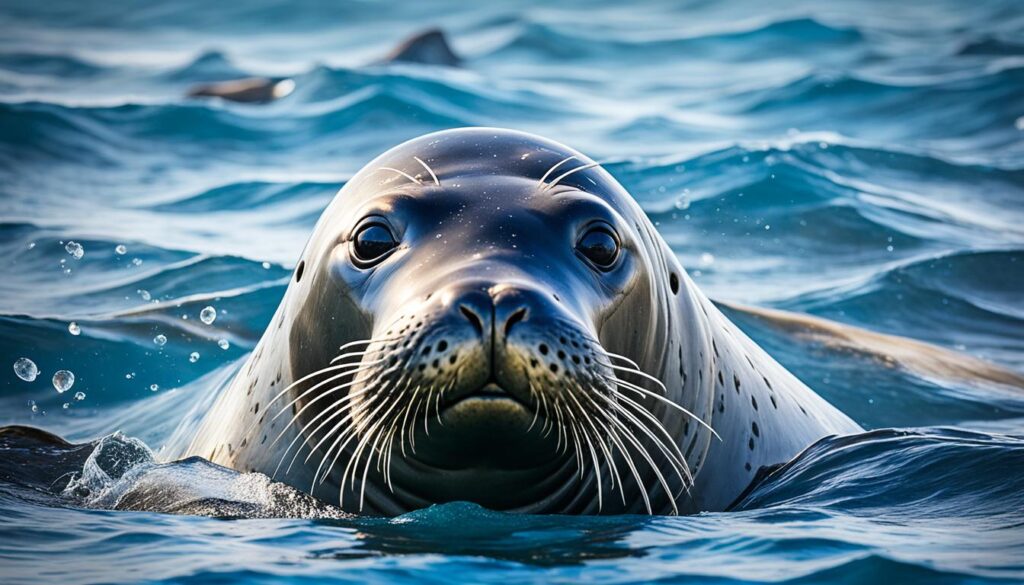
It’s fascinating to observe elephant seals in their natural habitat, whether on land or in the water. Their ability to adapt to the harsh marine environment and their remarkable diving skills make them true masters of the ocean.
Conclusion
In conclusion, the world is teeming with a plethora of fascinating animals that start with the letter E. These captivating creatures bring their own unique charm to the animal kingdom, captivating our imaginations and sparking our curiosity. From the majestic and intelligent elephants to the elusive and electric eels, each one showcases the diversity and wonder of the natural world.
Exploring and learning about these extraordinary creatures is not only an exciting adventure but also an opportunity to expand our understanding and appreciation of the fascinating creatures that share our planet. Whether it’s marveling at the iconic features of elephants, diving into the shocking mechanism of electric eels, or admiring the mighty hunting abilities of eagles, there is never a dull moment when discovering animals that start with E.
By delving into the lives and characteristics of these fascinating creatures, we gain a deeper connection with the natural world and the importance of preserving their habitats. Understanding their behaviors, roles in ecosystems, and unique adaptations allows us to appreciate the delicate balance of the Earth’s biodiversity. It is through this appreciation that we can take the necessary actions to protect and conserve the fascinating creatures that bring so much wonder and joy.
